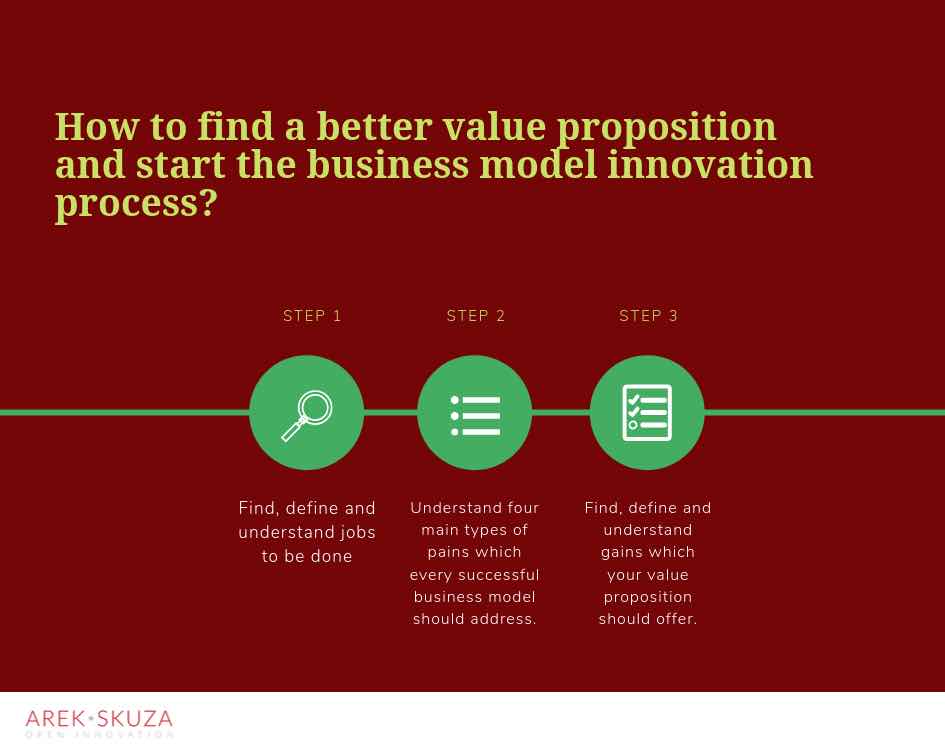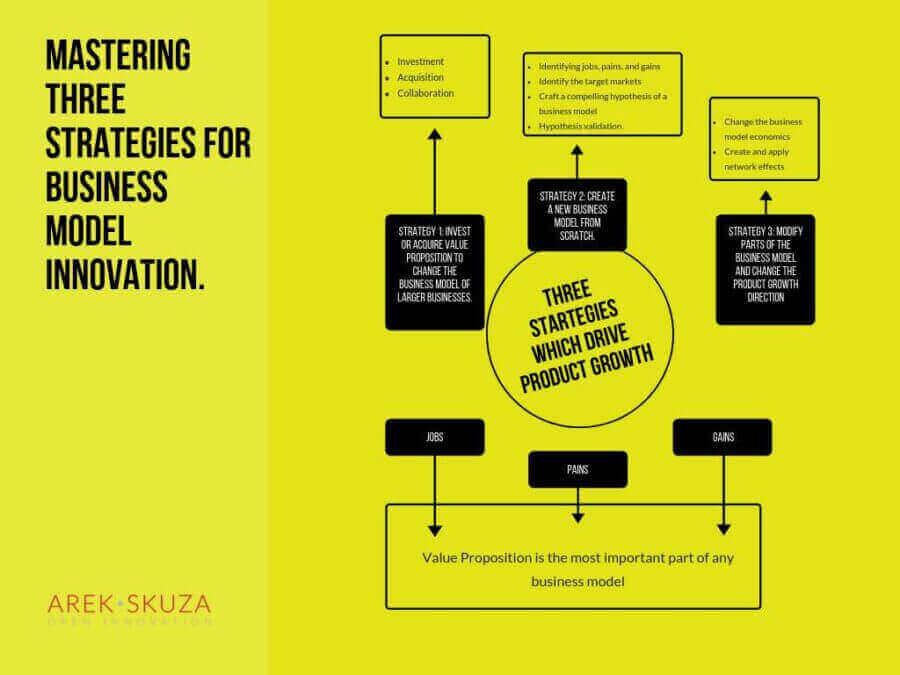Business model innovation was never as important as nowadays. Uncertain market forces are a challenge all companies face and are, in most cases, their primary source of risk. Shifts in customer habits, globalization, and technological innovations are currently creating difficulties for many businesses.
An operating model is nothing more than a representation of the full contexts of how a company generates value for its customers and then for itself.
What kind of questions, a powerful business model answer?

a) Who is the customer, and where is the customer segment/niche?
b) What does the customer value? It also answers the fundamental questions every business development manager must ask: How do we bring growth in this business? The reason for calling it growth not money is, for instance, new products are often free, so they don’t necessarily bring money but bring business growth (numbers of customers, number of digital products downloads, etc.).
c) What is the underlying business logic that explains how we can deliver a value proposition to customers at an appropriate cost?
d) What is the value chain the company needs to build and maintain to serve customers (partners, critical resources for organic growth, relationship with customers, customer service strategy)?
There must be a better way
A successful business offers a customer a better way of doing things than the existing options. It may provide more or different value to a customer segment. Alternatively, it may completely replace the old method of doing things and become the standard for the next generation. Eventually, a business model that offers the best way of doing things will win.
What does it mean “a better way of doing things” in terms of innovative models?
- Office workers hire laptops with software to create documents and build reports.
- Policeman hires cars to chase bad guys.
- Salesperson hires a smartphone salesforce app to handle customer transactions.
However, few businesses keep this in mind while searching for ideas for building powerful operations. Instead, they rely on inquiry methods, market reports, desk research, customer interviews.
To discover ways to innovate, companies can use the jobs to be done mindset and decompose tasks a customer is trying to mark as done.
Related: How does UBER constantly redesign the business model?
Jobs to be done review enables shifting the business model focus toward:
- The task the customer is trying to get done to maximize the value of her resources,
- Groups of individuals trying to get a job done define the market which is a substantial part of the business model, rather than focusing on a product or service features,
- Customers become job executors,
- It means that the company can group customers based on the challenges they experience in getting the job done.
How to find a better value proposition and start the business model innovation process?
The Value Proposition Canvas is an excellent tool for learning how customers make decisions and therefore helps us define value proposition which is the most relevant.

Step 1: Customers want a comfortable life. How to make sure that innovation strategy and models enable it.
Understanding customer jobs might include the list of tasks your customers are trying to accomplish what obstacles they are facing and what needs they’re trying to satisfy.
Some “jobs” examples which influence value proposition and business model:
- A company that supplies herbicides to farmers may decide that growers (the job executors) are working on destroying weeds, while the farmers’ actual challenge is to prevent weeds from germinating.
- A company that runs e-commerce business offers fast web search to fashion lovers, may decide that customers want to find apparel quickly, while the users’ challenge is to name clothing they saw in the store or at the party. It makes web searching job impossible to be done. In this particular case, giving people visual search (take a picture and buy) options is better than a fast web search experience.
The two examples explain how addressing customer challenges will deliver a better value proposition which is the most critical part of any business model.
Step 2: Growth is possible only if a business model removes target customer pains, and here are the four types of them.
Pains represent everything that makes customers’ life miserable before, during, and after trying to do the work. Pains also explain risks that are possible and unwanted outcomes resulting in poor performance or failure.
Like any difficulty, customer pains are diverse and varied. Here are the four main types of pains which every successful business model should address:
- Financial: Company customers are too much money on their current provider/solution/products (value proposition),
- Productivity: Company customers are losing too much time using their current provider/solution/products (again, value proposition) or desire to use their time differently,
- Process: Customers want to improve internal operations, such as cleaning the house, ordering food, hiring employees,
- Support: Customers aren’t receiving the support they need so they are not able to make decisions, or they need to spend money to outsource it.
Step 3: Customers expect gains continually, and your company should bring this by running a customer-centric business.
Step three will deliver the added value, which the customer experiences when a company introduces a new business model.
What are the gains
Gains explain the results and profits the company customers expect, desire, or would be amazed if the firm delivers them. Gains should cover the elements that make customers satisfied or happy rather than being the opposite of the pains.
A company that sells electric and autonomous cars not only solve problems (remove pains in offering value proposition) but can feel customer special among her friends. It is a crystal clear gain, which makes the customer more satisfied and more self-confident. In this particular example, a business model drives more organic growth to the car manufacturer, because the customer feels amazing when friends see her driving the car.
How to discover gains
The following list of questions help companies discover many gains which help to craft compelling value proposition and conduct business model innovation:
- Does the value proposition of your product provide positive social consequences that your client wants to experience?
- Does your product (and the value it brings) reflect some of the aspirations of your customer?
- Does your offering value proposition give specific results that meet the criteria for the achievements and frustrations of the customer?
These three activities will help your company define very solid and trustworthy customer evidence as you design your value proposition.
Design value proposition
Connecting jobs, pains, and gains will bring you to the point when value proposition will be shaped like the natural effect of extensive customer studies.
A value proposition is a promise of value to be produced by the business. It’s the principal reason a customer should order from your company. It’s also the number one thing that defines whether users will bother studying more about your product, or they will start studying competitors and their products.
A value proposition is compelling and keeps customers attention because:
- Creates a substantial difference between your company and your competitors which influence organic growth,
- Attracts the right potential customers and increases the number of quality leads,
- Gains market share in your targeted customer segments
- Improves your operation efficiency
The value proposition shapes all parts of a business model; it identifies and defines how a business model is providing new offerings meaning what the best distribution channels should be leveraged.
For instance, if the company launches a new product and targets small companies, the distribution channel is different than when the same company solves the pains and gains of large businesses. Furthermore, a compelling value proposition requires specific core capabilities, partnerships, resources, and influence the cost structure.
Related article: Business model design, redesign, and test in a structured way
Operating model innovation is the effect of studying customers and understanding their expectations which are afterward embedded into product features.
It drives product growth consequently and sustainably because the offering is deeply connected to customer preferences. Whenever customers perform a new task, feel new pain or expect new gain, the value proposition will adjust, for this reason, business model innovation is an ongoing process that can’t be abandoned if the company wants to grow organically.
Mastering three strategies for business model innovation.
Growth is top of mind at many businesses, and it can’t happen without delivering the best possible value proposition. Business model innovation requires continuously listening to customers and redefining value proposition. Three different strategies can bring a new or modified value proposition:

Strategy 1: invest or acquire value proposition
A large number of companies that invest or acquire smaller companies and startups aren’t doing it for the potential profits solely. Instead, they invest or buy smaller companies related to their interests to shore up weakening aspects of their business model.
Why are these companies making investments when it’s not their primary interest?
Mostly it’s because they acquire value proposition which then will serve the bigger player.
The business model which smaller company developed might not be working, but if the value proposition is compelling, then the big businesses will not hesitate to pursue an acquisition.
Case study: One of the most relevant examples of a business model innovation is the gaming broadcast service Twitch. The product launch process released what was called Justin.tv, one of Justin.tv’s executives developed a concept to use Justin.tv’s streaming technology as a service for gamers. They could go online and start a video broadcast their game-play where other players could log in to watch them play. The business model of the service drove such a fantastic value proposition that revenues skyrocketed and Amazon acquired Twitch in 2014 for close to $1 billion. Amazon completed the acquisition because it needed to bolster Amazon Web Services, the company cloud computing juggernaut. What happens later? Amazon launched Amazon Lumberyard, which is a free cross-platform game engine.
Related article: Amazon and Artificial Intelligence strategy
Building innovative models is an ongoing process, so companies like the one above, are always hunting for the next compelling value proposition which ensures the product growth.
If we consider value proposition as the perfect reflection of customers’ expectations, every acquisition or investment made by a larger company is an investment in the value proposition, not in the company itself.
Strategy 2: Create a new model from scratch
Draft value proposition
Identifying jobs, pains, and gains to prepare assumption for a value proposition
It’s important to start with first understanding a customer’s jobs to be done, pains and gains which I have already covered at the beginning of this post. Your work at this stage can be multi-faceted and complicated, meaning you probably list out many elements and it will be hard to prioritize them. I recommend focussing on listing out as many aspects and angles of the jobs, pains, and gains as possible.
Identify target markets
Identify the target markets which will appreciate the value proposition
Once you have a good understanding of pains and gains (fundaments of value proposition), it’s great to turn your focus on explicitly identifying the target market.
Generally speaking, I can list two elements that are crucial during business process innovation.
- It is essential to be as precise as possible about each potential target market in terms of jobs, pains, and gains.
- You will define, and sometimes you even should, multiple, different target markets. Please remember, we are setting a hypothesis about value proposition, so having various customer segments will help in the later stages of business process innovation if your first, second, or each next theory fails.
Let’s use Apple as a hypothetical example and company product innovations. Who are my potential target markets?
- First, someone wants to use the iPhone but has the problem (pain) of getting one because of the lack of financials. This group will appreciate flexible financing or trade-in deals.
- Second, somebody owns Mac but doesn’t own the iPhone. The customers can’t use iCloud and multitasking on many devices simultaneously. This group will value iCloud features as it will give them o lot of gains.
- Finally, the target market needs to be style informed. Great design, owning many devices make the person feel good, especially when friends surround the individual.
So, who fits these criteria from a demographic standpoint? Young professionals who need to work remotely and go to dinners often.
Corporate people who need to continually synchronize documents and go to meetings frequently to present or share documents. They value style as well because board rooms are full of VIPs.
These are the hypothesis which requires validation at the next stage of business model innovation.
Sketch the hypothesis
Crafting a compelling hypothesis of a business model is hard but it gets you closer to users.
Wave 3 is about creating a hypothesis and define them as easy to digest messages. This step is tricky because you need to take an enormous amount of data and convert it to 1–4 sentences. It can’t be a matrix of different pains and gains which customers experience.
What your business needs at this stage, is a great amount of work which aggregates all your problem and customer segment research is one clear hypothesis which will be a start.
I think a great way to achieve this is to combine a one-sentence outline of the problem with a one-sentence statement on what the customer segment expects instead.
Considering my Apple example, one hypothesis could sound like:
“Buying the iPhone is expensive; your professionals want more affordable financial options to buy a new iPhone.”
Validate the hypothesis
Validation of the value proposition is the process of collecting data and learnings around the business model through experimentation and customer testing. The goal is to eliminate or rebuild the initial hypothesis.
Here you will find three experiments you can apply in your business model innovation process:
a) customer interview
Leave the building and meet customers precisely when they spend their time. Customer interviews find out whether you are addressing a real pain, gain, and job. Alternatively, use these one-on-one interactions to obtain insights into whether your value proposition resonates with your customers, and your product can perform the growth if launched.
b) comprehension test
Comprehension test is simple to run, and it is a brilliant way to check if the customer segment recognizes the value proposition the same way you do. The plan is to examine if at least 80% of your customers understand your communication regarding the problem hypothesis. For instance, an “affordable financial model” can be interpreted differently by different users. By applying the comprehension test, you are checking the understanding of your value proposition, not whether they are interested in it.
c) one-feature MVP
“one-feature MVP” lets you validate the hypothesis with a quickly crafted prototype. It helps to avoid heavy concepts and unclear results by testing a one-feature minimum viable product (MVP). Feedback from the testing step will be used to:
- See if your value proposition can generate product growth,
- Find ways of improving the business model by redesigning the value proposition
- Estimate chances of significant growth once you lunch the new product
A successful “single feature MVP” testing stage will give you the numbers to justify the hypothesis development or redesign.
d) process simulation
Process simulation is a powerful validating technique for optimizing processes and making trusting, evidence-based conclusions. A simulation is an animated design that mimics the operation of an existing or proposed system, like the day-to-day operation of an insurance company, running a customer service return, or assigning a team at a call center.
Simulation models can be optimized for different factors such as improved time or cost (which can be rooted in pain, gains, and jobs to be done). Multiple scenarios can be built to test the different hypotheses of the value proposition and its impact on the business model innovation.
Strategy 3: Modify parts of the business model and change the product growth direction
The first action is to learn your business’s current business model. It’s essential to spend time mapping your business model using the framework of your choice (I recommend the Business Model Canvas). Once you know how your business model currently functions, you can start redesigning the existing parts of it. There is no one proper way to handle the process, but I suggest you start with the following recipe:
Business model economics
Change the business model economics, which influences your product growth in the most powerful way.
- Per item pricing (selling or launching products as individual units)
- Product bundles (selling products together like laptop and headphones)
- Service solutions (from maintenance and training to products bundled with services like iPhone and training in Apple brick and mortar stores)
- Time (Charge by a minute, hour, day or month)
- Access (Partial access to an event, information, database, also called a freemium business model)
- Subscriptions (instead of buying pet food every month, the company will send the product monthly for a subscription price)
- Memberships (single or group membership with or without tiers of value)
- Licenses (for a given time, or with escalating sets of features)
- Platforms (membership payments with or without revenue sharing business model)
Network effect
Create and apply network effects into the business model innovation process. There are various kinds of networks, each with practically unlimited growth opportunities:
- Builders Networks: Users use the software, developers build and launch platforms, which attracts developers to deliver new features (e.g., Apple Store, Amazon)
- User-Generated Content: Users design, create, populate and then utilize the content supplied by others, which drags more contributors (e.g., Facebook, YouTube, Twitch)
- Marketplaces: Buyers find sellers, sellers attract buyers.
- Adaptability: Adaptability executes collaboration which brings growth. One part provides tools with high compatibility and attracts more participants (e.g., Stripe, AWS)
- Data networks: Information collected from individuals is aggregated into something significant for all members of the system (e.g., Waze, Weather Channel)
With business models changing so rapidly today, having a great product isn’t enough. It would help if you also had a compelling value proposition and different strategies to innovate the business model.
Conclusion
Understanding your business growth profile is necessary so you can instantly and efficiently evaluate which products are in the growth trajectory and determine the right strategic direction to evolve your business model innovation?
Customers are always the answer, and their perspective influences your product growth the most.
If you want to learn from home about Artificial Intelligence, Product Strategy, and Product Management, check the LEARN FROM HOME section.


